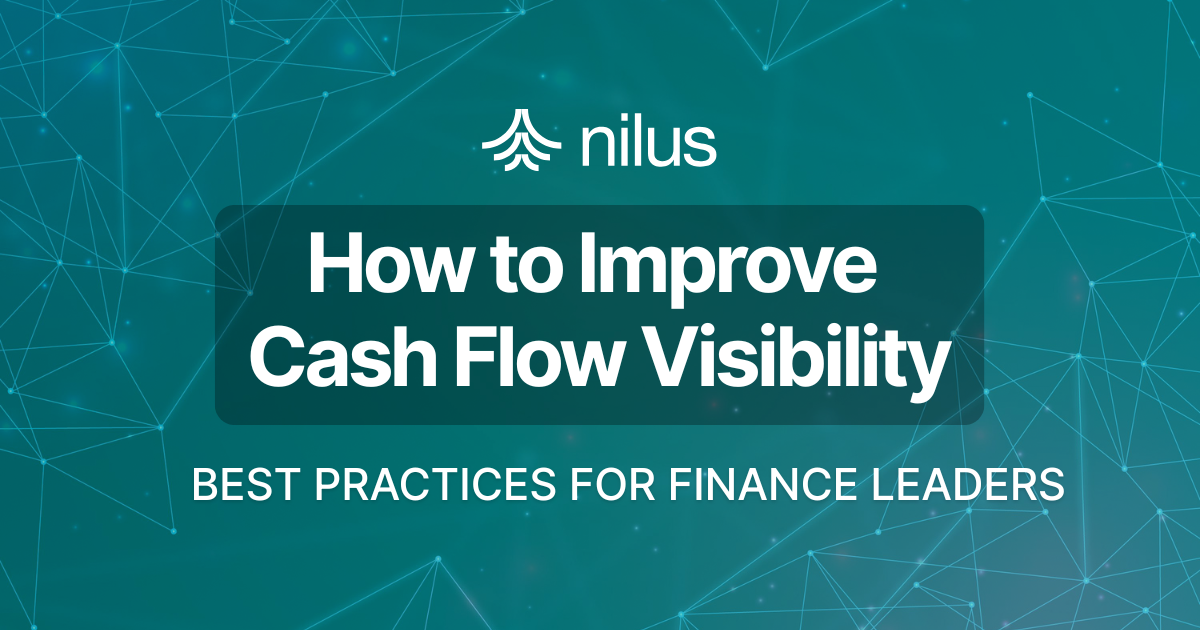Top 10 Prompts to Turn Data Into CFO-Ready Insights: Part 1

Introduction
The use of Generative AI and Large Language Models (LLM) is here to stay, so it is imperative for finance professionals to learn how to best utilize this technology within their respective functions. The ability to provide actionable insights vs data is not just a priority any more, it is a basic expectation. CFOs are no longer willing to wait for hours or even days for ad hoc financial analysis, when others are delving into insights in a matter of seconds.
In this article, we are going to explore how to optimize your prompts to deliver CFO-ready insights every time you engage with your financial data. Well-structured prompts are key to telling the right story to leadership, so you are not only responding with speed, but with the appropriate level of detail and accuracy.
Spotlight: See how Made In achieved 85% reconciliation time reduction and achieve real-time cash visibility here.
The prompts used will follow the ROLES Framework.
Role - Establish expertise and perspective
Objective - Define the task and desired outcome(s) clearly
Limits - Confirm scope, assumptions to make and things to avoid
Expectations - Define output format, the tone and desired sequencing
Safeguards - Confirm what to do if information is missing (avoid hallucinations)
There are many frameworks available to support prompt engineering. For role-based outcomes, leveraging the ROLES Framework is both effective and easy to remember! Having a more modular approach makes it easy to reuse components for similar or related prompts.
Note: Responses, where provided, are based upon the financial statements of a publicly traded software company. The responses have been intentionally anonymized, but with this information being available to the public it would not be a stretch to confirm the source of the data used to support the responses generated by ChatGPT.
1. Trend Analysis and Drivers
Avoid hours of manual analysis, creating trend lines, looking at max/mins, etc. with a short summary that highlights what actually matters to your CFO.
Prompt
Role: In the persona of a CFO of a publicly traded SaaS company [update company industry/type as required]
Objective: Review the attached financial statements (PDF), focusing on the income statement and key operational metrics. Analyze quarter over quarter revenue and expense trends. Identify the top 3 material drivers of impact to operating margin (such as variances > 5% and/or significant monetary impact).
Limits: Insights should come directly from numbers reported in the PDF. Do not infer any data not available and if the information is missing, pause and request additional inputs before attempting to provide a complete picture.
Expectations: Present 3 concise, executive level bullet points, each referencing numbers and %s for verification. Follow up with 2-3 recommendations on areas to explore further for more actionable insights (e.g. cost optimization, pricing or segment performance).
Safeguards: List any key assumptions made prior to sharing the analysis. Do not speculate - seek additional input or ask for clarification where necessary.
Response
What was interesting here is that ChatGPT walked through each step in its reasoning prior to delivering the below response, which took 46 seconds to completely render.

2. Forecast Accuracy Review
Help your CFO understand where assumptions made in the planning process break down. This is an analysis that will typically take hours to prepare and summarize prior to meeting with leadership, while still running the risk of running into costly errors.
Inaccurate forecasts are costing companies $465K per year on average in missed yield or unnecessary financing costs. Learn more about this forecasting blind spot here.
See how companies are leveraging tools like Nilus to easily build their bottom-up forecast, powered by AI.
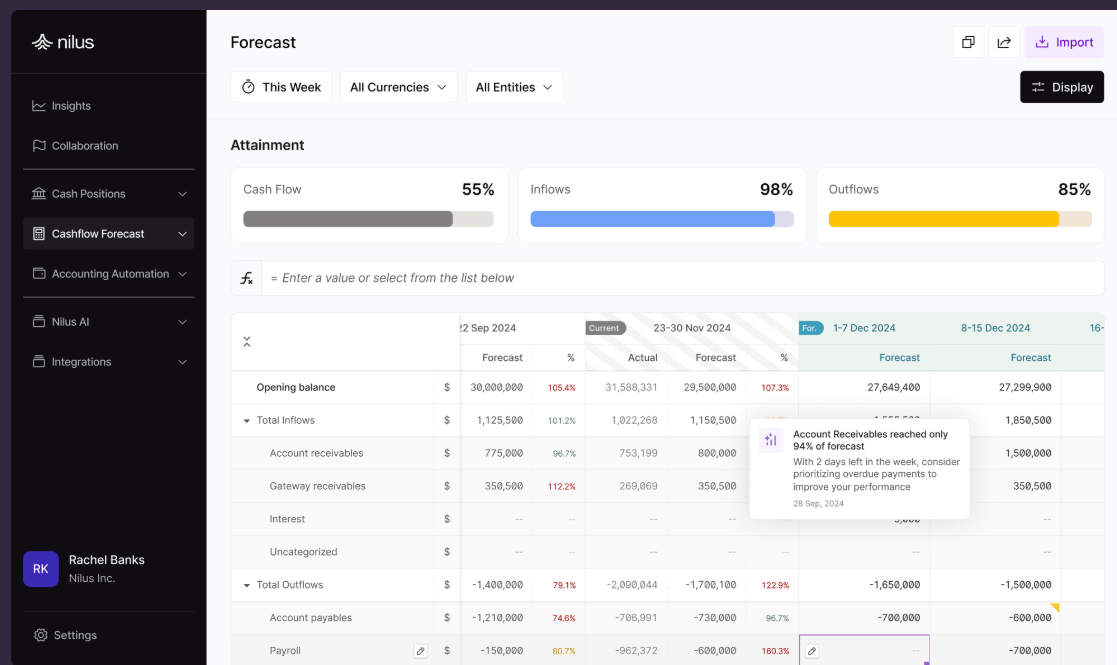
Prompt
Role: In the persona of a CFO of a publicly traded SaaS company.
Objective: Review the attached file (Excel) and compare the actuals vs forecast, focusing primarily on the income statement. Analyze the differences over the most recent 4 quarters that have data for actuals available. Identify the top 5 opportunities for improved discipline in the forecasting process, with reference to the larger variances.
Limits: Opportunities you identify should be inferred from the numbers reported in the Excel file. Do not infer any data not available and if the information is missing, pause and request additional inputs before attempting to provide a complete picture.
Expectations: Present 5 concise, executive level opportunities, each referencing numbers and %s for verification. Follow up on each opportunity with specific areas to explore further to generate more actionable insights (e.g. significant gaps in revenue, inflated expenditure categories or potential for missing spend).
Safeguards: When performing your analysis do not make any speculations. Seek additional clarification when required, even if that means pausing and requesting information before producing the final output. List any key assumptions made prior to sharing the final output.
Response
Interestingly here ChatGPT determined that the forecast and actual data provided was for different periods, when in fact it was clearly labelled as the same periods. After clarification on this it did pause again and request confirmation on analyzing the data quarter by quarter vs totals over the 4 quarter period provided.
The good news is that the LLM followed the prompt correctly by seeking additional input prior to running the analysis. Without the right prompt, I could be receiving incorrect analysis, which could in turn lead to incorrect business decisions.

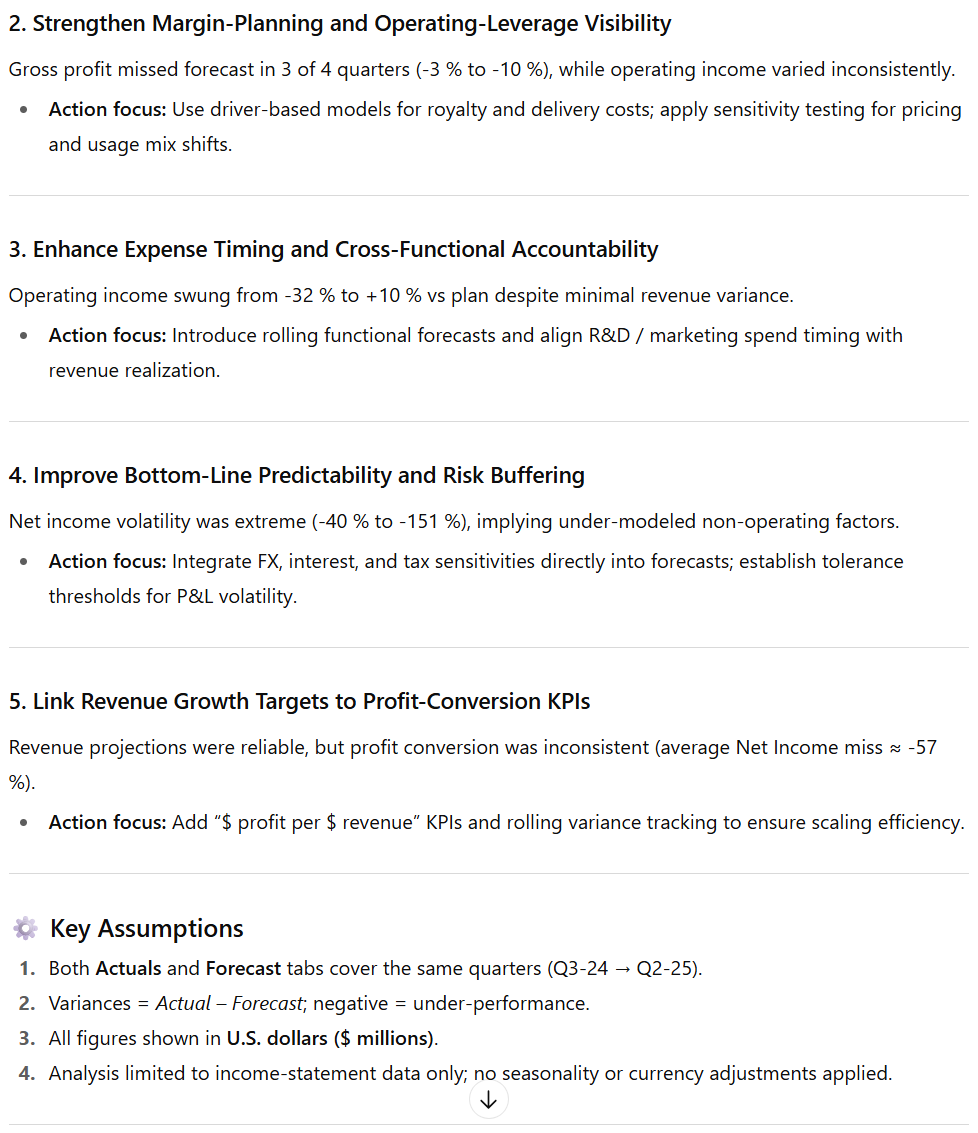
{{blog-cta}}
3. Working Capital Efficiency
Managing working capital is critical for all businesses. Having the ability to connect operational KPIs with cashflow conversations is going to help CFOs make data-backed decisions. This analysis can be performed in arrears by referencing financial statements, but can also be performed periodically throughout the quarter to support proactive decision making.
CFOs are leveraging AI-first tools such as Nilus to make these data-backed decisions in real-time, providing them a significant advantage over traditional reporting methods.
Prompt
Role: In the persona of a CFO of a publicly traded SaaS company.
Objective: Review the attached financial statements (PDF), focusing on the balance sheet (specifically AR, AP and inventory data) and calculate DSO, DPO and inventory turnover. Identify trends in these working capital metrics and flag cashflow conversion challenges, if any, that the CFO should act upon.
Limits: Use industry standard formulas for DSO, DPO and inventory turnover. Other than this, all other insights should be sourced directly from the numbers reported in the PDF. Do not infer any data not available. Instead, request additional inputs where necessary prior to providing the final output.
Expectations: First provide the calculations for the 2 most recent quarters and summarize the results. Confirm the drivers for the movement in each result (e.g. if DSO increased was that a result of an increase in AR relative to Revenue?) If the company does not manage inventory, simply exclude inventory turnover from your analysis.
Safeguards: List any key assumptions made prior to sharing the analysis. Do not speculate - seek additional input or ask for clarification where necessary.
4. Headcount and Productivity
Instead of looking at headcount numbers in a vacuum, CFOs can go deeper by cross referencing with revenue and expense data. Especially when the expense data is broken out by department. Doing so allows for the tracking of output per employee across different teams and also more holistically when considering revenue per employee.
Prompt
Role: In the persona of a CFO of a publicly traded SaaS company.
Objective: Review the attached files and consider them as key inputs for analysis.
- File 1 - Headcount by department by month (Excel format)
- File 2 - Income statement by department by month (Excel format)
Analyze the month over month trends for the top 10 departments, by total expenditure. Calculate the average cost per employee for each of the top 10 departments and identify those with the biggest % increases over the past 6 months. If there are less than 10 departments with significant spend or headcount, only analyze those with significant spend. A minimum of 5 departments should be reported.
Limits: All insights should be derived from the numbers provided in the attached files. Do not infer any data not available in the attached files. If necessary, pause your analysis and request additional context before producing the requested output.
Expectations: Start by presenting the top 5-10 departments, sorted by average cost per employee (highest to lowest) based upon the most recent month available in the datasets. Call out departments with the highest dollar and % increases in average cost per employee over the past 6 months. Follow up with 2-3 recommendations in total for specific departments to drill down further into to generate actionable insights. The recommendations will likely include questions to be posed to respective department leaders on both their headcount % changes and overall cost % changes.
Safeguards: List any key assumptions made prior to sharing the analysis. Do not speculate - seek additional input or ask for clarification where necessary.
5. Expense Optimization
Not all expenses are the same. Some are fixed, some variable and some a hybrid of the two. Some expenses support “keeping the lights on” whereas others support employee efficiency. It is important for CFOs to understand which expenses they can influence “controllable costs” vs those that are not as controllable.
While the categorization of expenses can differ from company to company, there are common expenses that apply to most (if not all) companies, e.g. office rent is typically fixed/predictable, whereas server usage costs are primarily variable. Knowing what levers the CFO can pull will keep focus on what can be controlled or optimized.
CFOs are reducing operational costs by as much as 40%, by automating manual tasks with Nilus AI.

Prompt
Role: In the persona of a CFO of a publicly traded SaaS company.
Objective: Review the attached income statement by department by month (Excel format) and categorize each expense line into controllable vs non-controllable costs. Identify the top 5 controllable expense categories with the largest % growth year over year. If there are one or two departments contributing significantly toward the % growth please highlight those as well so it is clear where the drivers of % growth are coming from within the company.
Limits: While the numbers referenced should be derived from the attached file, it is OK to infer expense categorization based upon common business practices in the SaaS vertical. [update company industry as required]. If you need clarity on whether a specific expense should be categorized as controllable or non-controllable, pause the analysis and ask for confirmation, then continue the analysis.
Expectations: Start by presenting the top 5 controllable expense categories with the largest % growth year over year and stack rank these based upon total value increase. Next, flag the departments that are driving the % increase across these categories and provide 3-5 total recommendations for areas to investigate further with the respective department leaders. Recommendations should be summarized by department and not by expense category to support live discussions.
Safeguards: List any key assumptions made prior to sharing the analysis. Do not speculate - seek additional input or ask for clarification where necessary.
Response
The results here are a good example of the need to provide the details if you’re looking for detailed answers. The response from ChatGPT is pretty high level, because I provided high level income statement data by department. For better recommendations and outcomes I would plan on loading a more detailed level income statement by general ledger account next time!
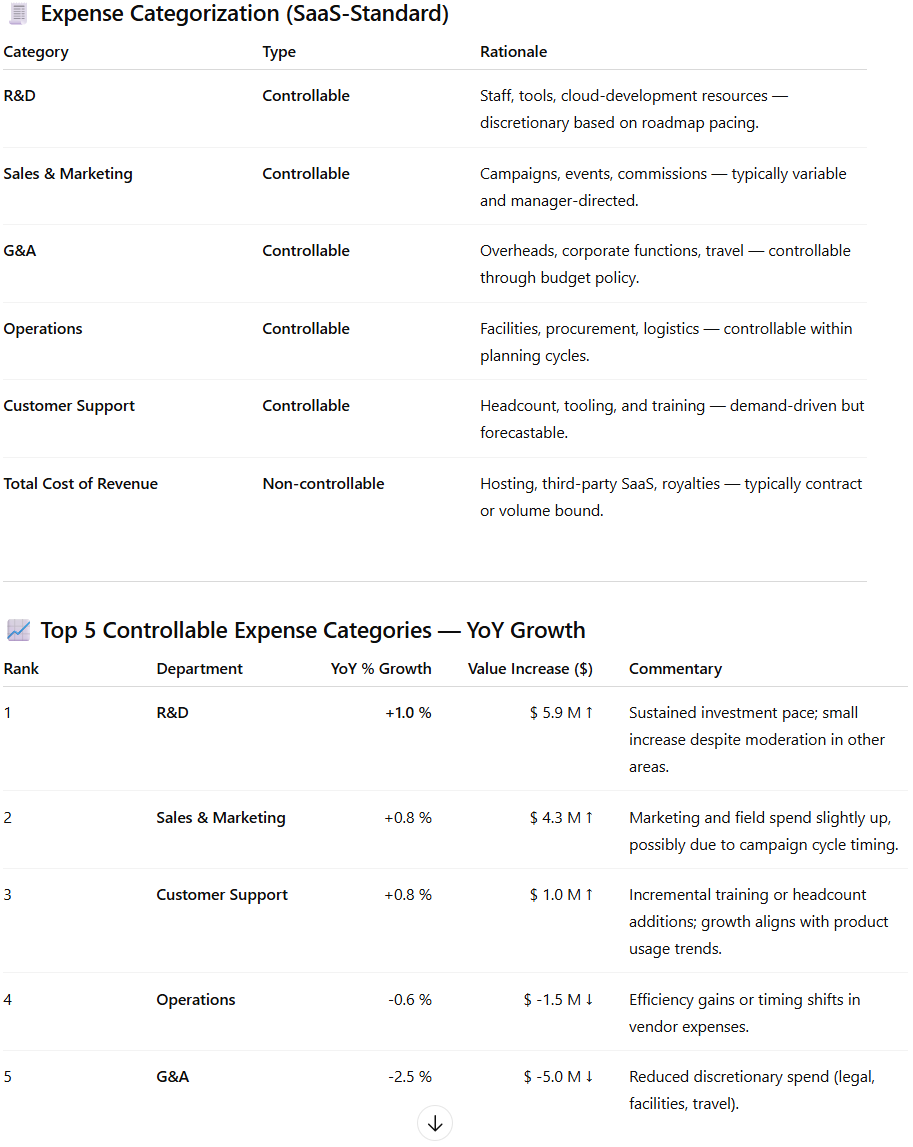
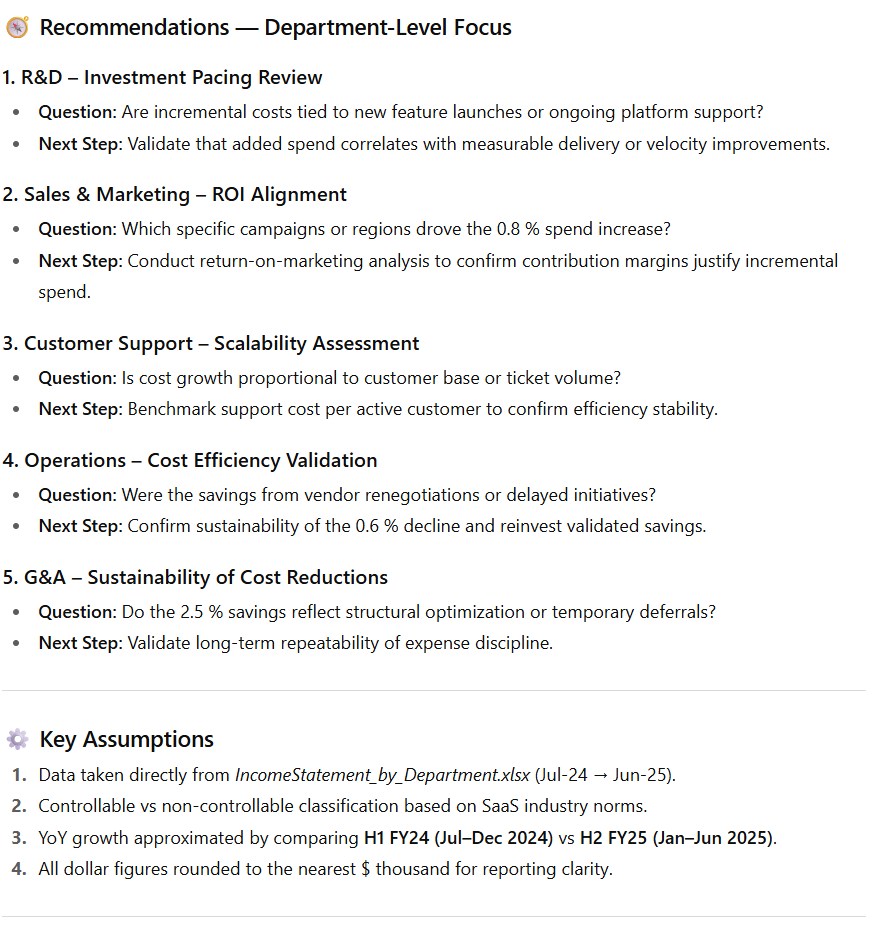
Final Thoughts
By leveraging the right prompts, CFOs can gain insights into a company’s financial operations within a matter of seconds. It is still important to “trust and verify” as less specific prompts can lead to hallucinations or just incorrect conclusions. You can mitigate, but not eliminate this risk by leveraging a consistent prompt framework that will ask the LLM to seek clarity when necessary and flag any assumptions made after seeking the additional clarity.
Taking this approach leads to more productive discussions with company leadership, as insights that have traditionally relied upon hours of manual effort from Treasury teams and FP&A teams can now be summarized, with actionable lines of questioning in a matter of seconds!
Is your team ready for the next evolution of treasury operations? Ask yourself these 10 questions before choosing an AI treasury platform!
Your next treasury move is waiting
Get an ROI assessment, and find out where you’re leaving cash on the table.

Your next treasury move is waiting
Get an ROI assessment, and find out where you’re leaving cash on the table.

More Resources
Your next treasury move is waiting
Get an ROI assessment, and find out
where you’re leaving cash on the table.






